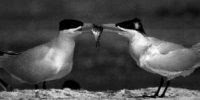
The bird lived for a time in the cage, is accustomed to people and ceases to be shy. It ceases to look for food, getting it ready, and most importantly, loses the ability to be alert. Issued from the cells of birds often become victims of predators, fall under the wheels of cars and simply die of hunger. Therefore, a man who has decided to take the bird to his home, must remember that it takes the whole "bird" life.
Cell shape and size depend on to what bird they are and for what purpose you intend to keep it. Males songbirds kept separately in small cell, which makes it possible to fully enjoy their singing.
Canary or goldfinches and other songbirds small size of the cells contain a length of 50 cm, height 35 cm and a width of 30 cm with a starling-sized bird cage needed a little more - the length of the cell must be at least 70 cm, height - 60, width - 40 cm . cage for a parrot, for example, Grays, or Amazon, even more - the length and height of 80 cm, width 55 cm
Avoid small birds placed in a large cage. In such a cage bird feels uncomfortable, little singing, itself reduces the size of his home, holding only a small part of it. You can not put the birds in too small for these cells, in which the birds or sit motionless on a perch, so that get fatter and die quickly, or because of the narrowness break their feathers on the tail and wings.
The form of the cells is also important. The most practical rectangular cells, with no protrusions, often with flat top, with the exception of cells for Klestov, which is recommended to put in a cage with a domed top. Architectural excess cells not only make it difficult to clean, but also contribute to the reproduction of blood-sucking arthropods.
It is also a place for the cell. Most importantly - enough sunlight and lack of drafts. Is a suitable place at the side or opposite the window wall of the room to the sun's rays shining on her 2-3 hours a day. Do not install a cage on the window sill to avoid overheating and cold bird!
Cells of larger sizes - cages used for group content of small birds. The optimum size of cages - 80 cm by 35 cm by 35 cm are kept young birds that require a lot of movement to strengthen the muscles. In the cages can be propagated small songbirds and small parrots, putting them back in pairs.
To produce cells use different materials - wood, plastic, metal, organic and silicate glass. Twigs cells made of stainless or galvanized wire, or bamboo. For birds, splitting the wooden parts of the cells with their powerful beaks - parrots, crossbill and others, better to use metal cage. There are cells of the so-called box-type, in which only one side covered with netting or twigs, and others - solid, made of Plexiglas or opaque materials. Box feeders cells, set on one another, form a bird's wardrobe, they are suitable for breeding birds, as well as in teaching young canaries in the shade of the curtains open. In cells with a soft-top contain larks and some other insectivorous birds, which are in strong fear tend to take off vertically and in an ordinary cell can get hurt badly.
The bottom of the cage, pallet, must be rising. He poured out on the big river sand, washed from the dust and debris, and calcined in the fire or in the oven. Pallet better make of galvanized iron.
In each cell must be placed perches, whose diameter should be almost equal to the coverage fingers feet. Perches need to have at such a distance from each other, so that birds can easily jump from one to another, barely flapping their wings, and that while on a perch, not contaminated by their faeces food and water, as well as the tail of each other. The number of perches depends on destination cell. For land birds, such as a lark, perches are not necessary, you can replace them with hemp or bumps.
Finally, let me say goodbye to the next part. To be continued! Good luck to you, dear, Dear Readers!
Dmitry Kolpakov
http://animaldin.blogspot.com/










